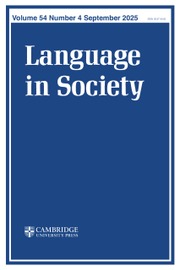Article contents
Interactional prosody: High onsets in reason-for-the-call turns
Published online by Cambridge University Press: 07 March 2001
Abstract
The present study demonstrates how prosody – specifically, onset level – is deployed in situated interaction to cue frames of interpretation for talk. It shows not only that final pitch level in intonational contours is a relevant parameter, but also that, under certain conditions, initial pitch level may provide a situationally specific contextualization cue. In calls to radio phone-in programs, for instance, there is a so-called anchor position where callers can be expected to announce the reason for their calls. Close empirical analysis of data from such a program reveals that it is here that the first turn-constructional unit is routinely formatted with high onset. The studio moderator displays an orientation to this kind of prosodic formatting by withholding further talk until the caller has made a recognizably complete statement of the reason for the call. On occasion, turn-constructional units in anchor position are heard to lack a high onset. When this happens, the moderator responds in a way that shows he is not treating callers' talk as the reason for the call, but rather as a preface to the statement of reason.
Keywords
- Type
- Research Article
- Information
- Copyright
- 2001 Cambridge University Press
- 52
- Cited by


